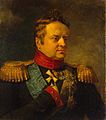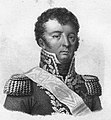Battle of Stockach
| date | March 25, 1799 |
|---|---|
| place | Stockach |
| output | Retreat of the French |
| Parties to the conflict | |
|---|---|
| Commander | |
| Troop strength | |
| 36,000 | approx. 70,000 |
| losses | |
|
approx. 4,000 |
1 general, 156 officers 5,756 men and 2 guns |
Ostrach - Feldkirch - Stockach I - Verona - Magnano - Cassano d'Adda - Frauenfeld - Winterthur - Zurich I - Trebbia - Mantua - Novi - Vlieter - Bergen - Zurich II - Muotatal - Egmont - Genola - Wiesloch - Genoa - Stockach II - Engen - Meßkirch - Biberach II - Montebello - Marengo - Höchstädt - Oberhausen - Hohenlinden - Walserfeld - Pozzolo - Copenhagen - Algeciras I - Algeciras II
In the battle of Stockach (actually Battle of Liptingen ) on March 25, 1799 four days after the Battle of Ostrach , the defeated there French under attacked General Jourdan again under Archduke Charles nachsetzenden Austrians to the on Feldkirch previous General Massena to relieve. The French withdrew towards Villingen after losing initial successes . In the battle, Prince Karl Aloys zu Fürstenberg (1760–1799) fell on the Austrian side . General Jourdan was then replaced as military leader.
The political situation in 1799
The First Coalition War ended in 1797 with the Peace of Campo Formio . Since this treaty had only been concluded between Austria and France, the political consequences for the empire were to be negotiated at the Rastatt Congress , which began in December 1797 .
With the conquest of Malta by France and the incursion of French troops into Egypt , the ground was prepared for the Second Coalition , in which Russia , Turkey and Great Britain initially allied against France. Austria initially held back. However, after allowing a Russian army to pass through Austria towards the Italian theater of war and the Russian army had reached Austrian territory in February 1799, France viewed this as a breach of the Treaty of Campo Formio. In 1797, Austria had withdrawn its troops far from the French border to beyond the Lech in Tyrol , in accordance with the relevant treaty text . France crossed the Rhine on March 1, 1799 and invaded Upper Austria without declaring war. This only took place on March 12th, when the French Danube Army was already north of Lake Constance .
Before the battle
After the lost battle at Ostrach , the French troops withdrew via Pfullendorf on a line Singen - Engen - Tuttlingen , the Austrian troops followed. On March 24, there was fighting on both wings. While Merveldt the Division of Saint-Cyr from Neuhausen ob Eck and Liptingen could displace met Schwarzenberg between Singen and Radolfzell with Ferino together, where he could keep his positions in the forest area. The vanguard of the Austrian troops stood on the evening of March 24th in the line Steißlingen - Eigeltingen - Liptingen.
Course of the battle
Archduke Karl wanted a decisive battle, but did not dare to attack directly because he did not know exactly where which enemy formations were. So he ordered a slow advance all along the line to clear up the situation on March 25th - Easter Monday - but only used the avant-garde .
Jourdan intended to make up for his numerical inferiority with a surprise attack.
General Merveldt began his advance on Emmingen on the right wing , from which he was initially able to drive the French. He realized too late that formations of three French divisions were marching on Liptingen. He wanted to withdraw in an orderly manner from the outnumbered opponent on Stockach, but this degenerated into a disordered escape due to a rapid French attack.
Nauendorf advanced with his troops from Eigeltingen via Aach towards Engen. He met units of the Saint Cyr division, and when these were reinforced by the Souham division, he had to withdraw to Eigeltingen. In the south of the combat area, the Schwarzenbergs clashed with the Ferinos again. The Austrians were able to stop the French here in front of the Nellenburg and Stockach.
Jourdan was of the opinion that the fleeing units from Merfeld were the main Austrian army and wanted to postpone their retreat in order to achieve a total victory. For this purpose he ordered Saint Cyr to Pfullendorf. Weakened in this way, he then moved against the units of Petrasch and Fürstenberg, which were now intervening, and were reinforced by Kolowrat's troops drawn from the Stockach area. The eventful battle in the Liptingen area was ultimately decided by the deployment of Austrian cuirassier regiments under Field Marshal Lieutenant Johann Siegmund Graf von Riesch against the French cavalry. In this battle for Liptingen, Karl Aloys zu Fürstenberg also fell.
After the battle
That night, Saint Cyr managed to cross the Danube at Laiz and thus avoid being cut off from his own main army. To relieve Ferino early in the morning on March 26th at Wahlwies another relief attack . Jourdan withdrew towards the Black Forest in the following days. He himself left the army on April 3rd and his chief of staff Jean Augustin Ernouf led the troops back to the Rhine Valley, where they crossed the Rhine on April 5th and returned to France.
Appreciation
Clausewitz criticizes both commanders in chief. Archduke Karl acted too timidly with his numerical superiority. He blames Merfeldt for the disorderly flight of the avant-garde on the left wing. Jourdan is criticized by him for daring a loss-making attack, hopelessly outnumbered, because he did not want to be dragged into inaction by the Paris Directory.
The generals
Generals of the Austrian army in southern Germany
Maximilian Friedrich von Merveldt , avant-garde right wing
Karl Philipp zu Schwarzenberg , avant-garde left wing
without picture: Olivier Remigius Count von Wallis Freiherr von Karighmain (commander right wing); Friedrich August von Nauendorf (Avantegarde Center), Joseph Staader von Adelsheim , Franz Freiherr von Petrasch , Vincenz Maria Joseph Graf von Kolowrat-Liebsteinsky , Johann Siegmund Graf von Riesch
Generals of the French Danube Army
Jean-Baptiste Jourdan , Commander-in-Chief of the Danube Army
François-Joseph Lefebvre , commander of the avant-garde
Pierre Marie Barthélemy Ferino , Commander of the 1st Division (right wing)
Joseph Souham , commander of the 2nd Division
Laurent de Gouvion Saint-Cyr , commander of the 3rd division
Jean-Joseph Ange d'Hautpoul , reserve commander
Nicolas Jean-de-Dieu Soult , represented Lefebvre after he was wounded
literature
The battle in local history
- Municipality of Emmingen-Liptingen (editor): Battle of Liptingen 1799 - memorial , Tuttlingen 1999
- Edwin Ernst Weber (ed.): Ostrach 1799, The battle, the place, the commemoration . Ostrach 1999, ISBN 3-00-004325-X
- Johann Baptist Trenkle: The Liptinger battle, briefly described by an eyewitness , 1868
- F. König: A hundred years ago !: an anniversary pamphlet about the battle of Stockach (March 25, 1799) , 1899
- Hermann Pfeiffer: The Battle of Stockach on March 25, 1799 , in: Writings of the Association for the History of Lake Constance and its Surroundings , 54th year 1926, pp. 28–71 ( digitized version )
- Georg Tumbülle: 100 years ago. - The battles near Ostrach and Stockach-Liptingen In: Writings of the association for history and natural history of the Baar and the adjacent parts of the country in Donaueschingen. X. Issue 1900, Tübingen 1900, pp. 68–82 online (PDF; 26.8 MB)
The view of the military theorists
- Carl von Clausewitz : Left behind works on war and warfare - The campaigns of 1799 in Italy and Switzerland , Berlin 1833, fifth volume, p. 122ff. ( online in Google Book Search )
- Antoine Henri Baron de Jomini : Histoire critique et militaire des guerres de la Revolution , Paris 1822, pp. 126-139 ( online in the internet archive )
- JE Woerl: History of the wars from 1792 to 1815, with battle atlas , Freiburg i.Br. 1847, pp. 86–88 ( online in Google Book Search )
Representations of the two generals
- Archduke Karl of Austria: History of the campaign of 1799 in Germany and Switzerland , Vienna 1814, Volume 1, pp. 187–227 online in the Bavarian State Library digital
- Jean-Baptiste Jourdan: Memoir of the Operations of the Army of the Danube , London 1799, pp. 173ff. (Translation from the general's French diary) - English online in Google Book Search
Web links
Individual evidence
- ↑ a b K. u. k War archive (publisher): Austria's wars since 1495. Chronological compilation of the battles, skirmishes, sieges, etc. in which imperial troops participated in the various theaters of war either alone or with their allies. From the time of Emperor Maximilian I in 1495 to the most recent times. Vienna 1878, p. 93 digitized
- ↑ Secret Article XIII. "... to their hereditary lands ..."
- ↑ Tumbühlt p. 76
- ↑ Clausewitz (p. 125) scoffs "This is an ancient favorite use of the Austrians when they lack the spirit of enterprise and they begin to feel ashamed"
- ↑ The order of battle can be found in the English Wikipedia Order of battle at the Battle of Stockach (1799)
-
↑ Wikisource: BLKÖ: Riesch, Johann Sigmund Graf - Sources and full texts
- ↑ Tumbält p. 81
- ^ The Ferino division on April 5th near Breisach, the other divisions on April 6th near Kehl, s. Clausewitz p. 140
- ↑ "... he lacks the spirit of enterprise and the thirst for victory." Clausewitz p. 153
- ↑ s. Clausewitz p. 133
Coordinates: 47 ° 51 ′ 0 ″ N , 9 ° 0 ′ 0 ″ E













